Research on Fibre Reinforced Concrete with Polypropylene and Steel
VerifiedAdded on 2020/05/04
|10
|3247
|74
Project
AI Summary
This research project investigates the stress-strain behavior of hybrid fibre reinforced concrete, focusing on the impact of varying proportions of polypropylene and steel fibers. The study aims to analyze the compressive strength and workability of concrete mixtures with different fiber contents (0%, 0.5%, 1.0%, 1.5%, and 2.0% by volume) and ratios (100:0, 75:25, and 50:50). The research involves experimental work on M20 grade concrete, including casting and testing cube and cylindrical specimens. The literature review covers existing models and studies on fibre reinforced concrete, highlighting the importance of stress-strain curves in understanding material behavior and the need for ductility in concrete structures. The methodology includes material selection, specimen preparation, and compression testing to obtain stress-strain curves, which are then normalized for comparison. The study seeks to determine the optimal combination of fibres for enhancing hardened concrete properties and improving its performance in construction applications. The project also discusses existing research on the topic, providing a comprehensive overview of the current understanding of fibre reinforced concrete.
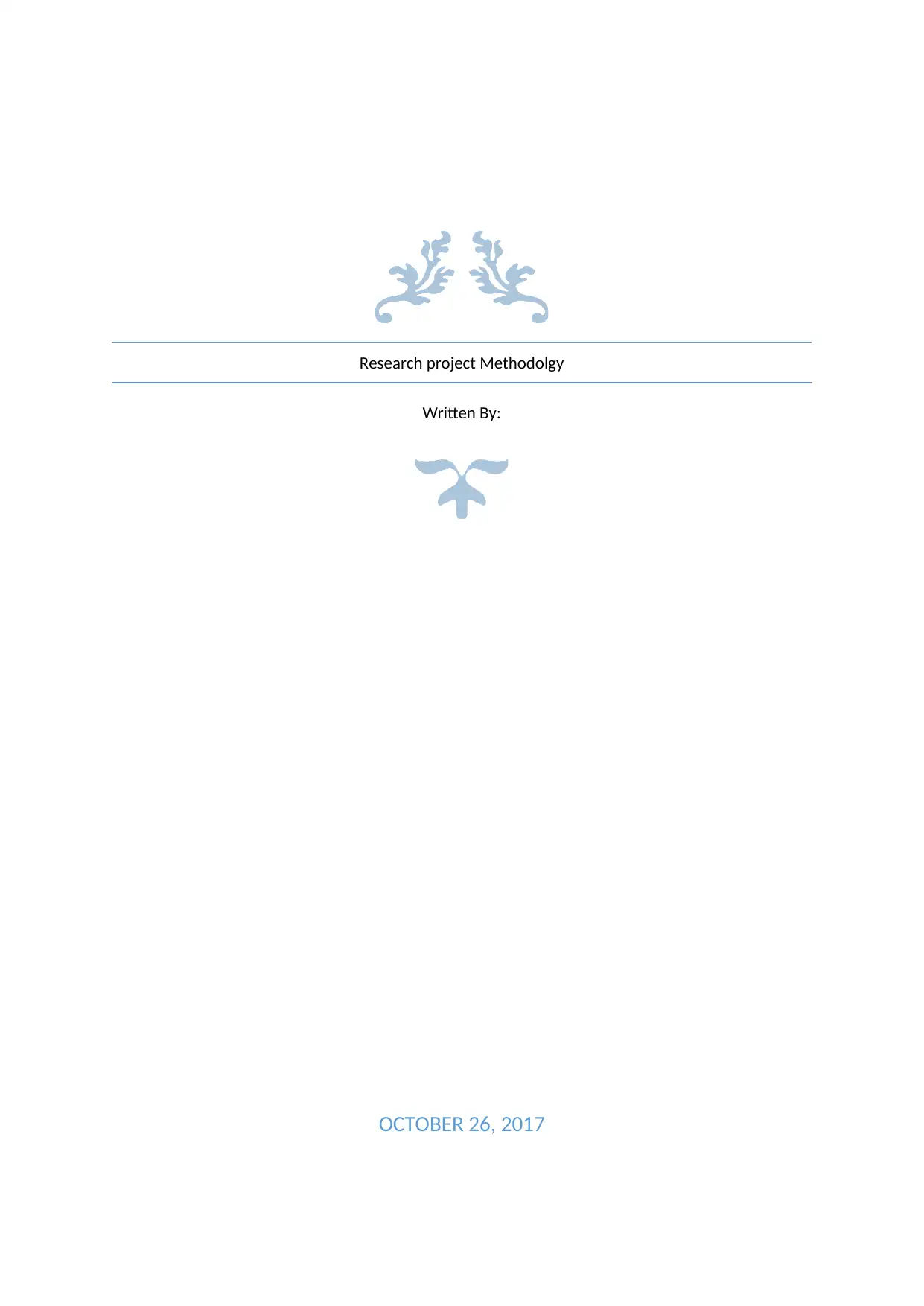
Research project Methodolgy
Written By:
OCTOBER 26, 2017
Written By:
OCTOBER 26, 2017
Paraphrase This Document
Need a fresh take? Get an instant paraphrase of this document with our AI Paraphraser
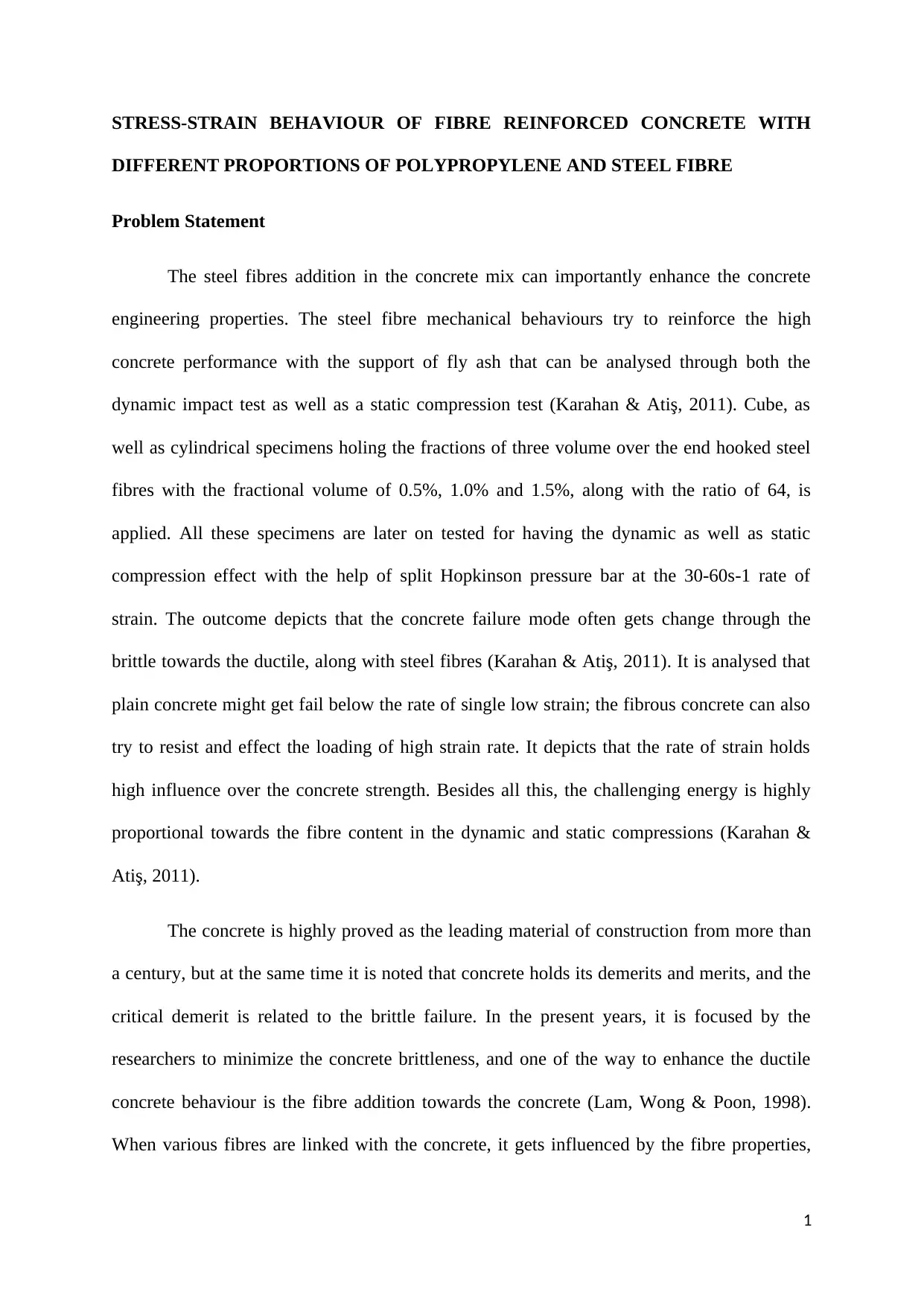
STRESS-STRAIN BEHAVIOUR OF FIBRE REINFORCED CONCRETE WITH
DIFFERENT PROPORTIONS OF POLYPROPYLENE AND STEEL FIBRE
Problem Statement
The steel fibres addition in the concrete mix can importantly enhance the concrete
engineering properties. The steel fibre mechanical behaviours try to reinforce the high
concrete performance with the support of fly ash that can be analysed through both the
dynamic impact test as well as a static compression test (Karahan & Atiş, 2011). Cube, as
well as cylindrical specimens holing the fractions of three volume over the end hooked steel
fibres with the fractional volume of 0.5%, 1.0% and 1.5%, along with the ratio of 64, is
applied. All these specimens are later on tested for having the dynamic as well as static
compression effect with the help of split Hopkinson pressure bar at the 30-60s-1 rate of
strain. The outcome depicts that the concrete failure mode often gets change through the
brittle towards the ductile, along with steel fibres (Karahan & Atiş, 2011). It is analysed that
plain concrete might get fail below the rate of single low strain; the fibrous concrete can also
try to resist and effect the loading of high strain rate. It depicts that the rate of strain holds
high influence over the concrete strength. Besides all this, the challenging energy is highly
proportional towards the fibre content in the dynamic and static compressions (Karahan &
Atiş, 2011).
The concrete is highly proved as the leading material of construction from more than
a century, but at the same time it is noted that concrete holds its demerits and merits, and the
critical demerit is related to the brittle failure. In the present years, it is focused by the
researchers to minimize the concrete brittleness, and one of the way to enhance the ductile
concrete behaviour is the fibre addition towards the concrete (Lam, Wong & Poon, 1998).
When various fibres are linked with the concrete, it gets influenced by the fibre properties,
1
DIFFERENT PROPORTIONS OF POLYPROPYLENE AND STEEL FIBRE
Problem Statement
The steel fibres addition in the concrete mix can importantly enhance the concrete
engineering properties. The steel fibre mechanical behaviours try to reinforce the high
concrete performance with the support of fly ash that can be analysed through both the
dynamic impact test as well as a static compression test (Karahan & Atiş, 2011). Cube, as
well as cylindrical specimens holing the fractions of three volume over the end hooked steel
fibres with the fractional volume of 0.5%, 1.0% and 1.5%, along with the ratio of 64, is
applied. All these specimens are later on tested for having the dynamic as well as static
compression effect with the help of split Hopkinson pressure bar at the 30-60s-1 rate of
strain. The outcome depicts that the concrete failure mode often gets change through the
brittle towards the ductile, along with steel fibres (Karahan & Atiş, 2011). It is analysed that
plain concrete might get fail below the rate of single low strain; the fibrous concrete can also
try to resist and effect the loading of high strain rate. It depicts that the rate of strain holds
high influence over the concrete strength. Besides all this, the challenging energy is highly
proportional towards the fibre content in the dynamic and static compressions (Karahan &
Atiş, 2011).
The concrete is highly proved as the leading material of construction from more than
a century, but at the same time it is noted that concrete holds its demerits and merits, and the
critical demerit is related to the brittle failure. In the present years, it is focused by the
researchers to minimize the concrete brittleness, and one of the way to enhance the ductile
concrete behaviour is the fibre addition towards the concrete (Lam, Wong & Poon, 1998).
When various fibres are linked with the concrete, it gets influenced by the fibre properties,
1
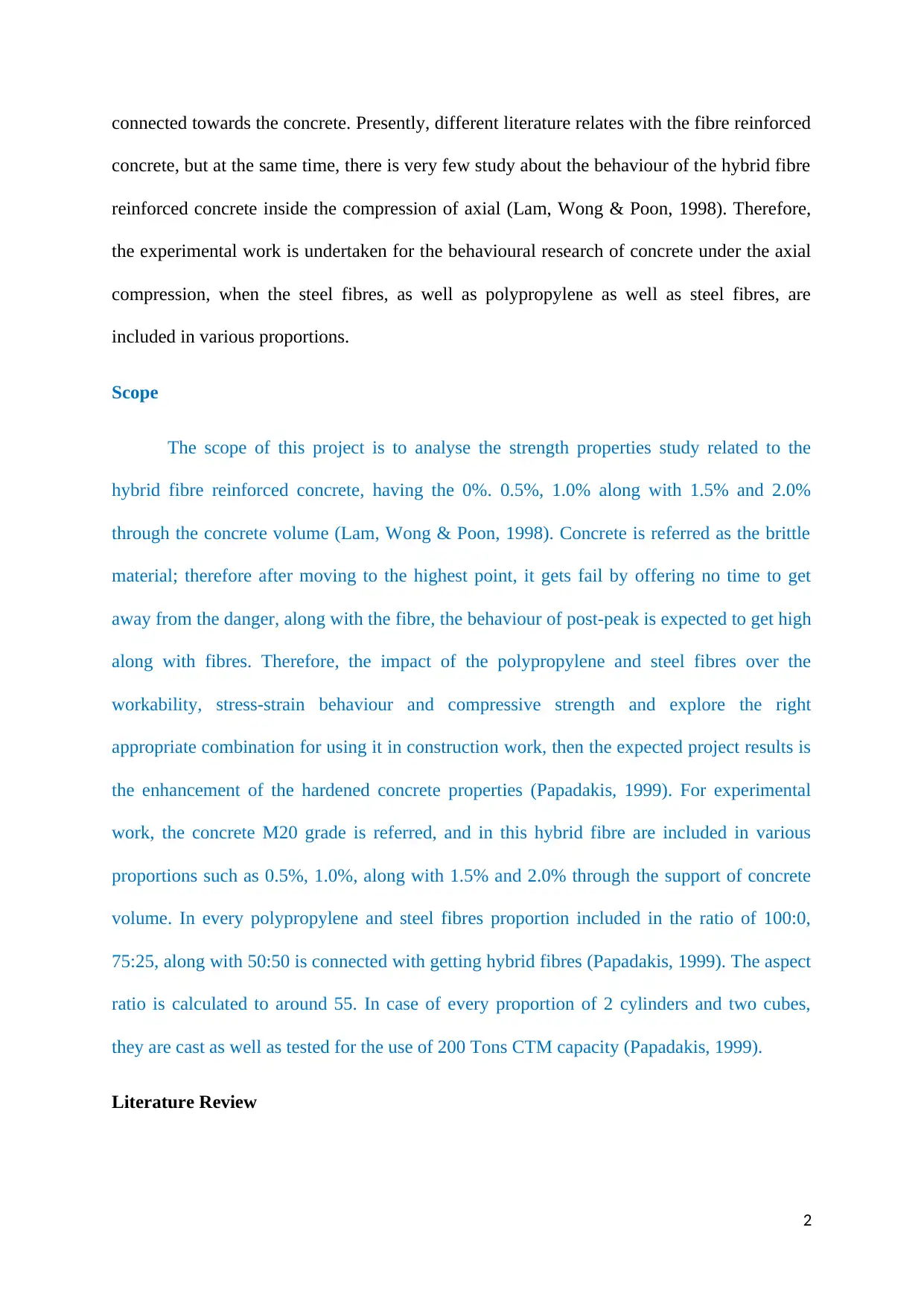
connected towards the concrete. Presently, different literature relates with the fibre reinforced
concrete, but at the same time, there is very few study about the behaviour of the hybrid fibre
reinforced concrete inside the compression of axial (Lam, Wong & Poon, 1998). Therefore,
the experimental work is undertaken for the behavioural research of concrete under the axial
compression, when the steel fibres, as well as polypropylene as well as steel fibres, are
included in various proportions.
Scope
The scope of this project is to analyse the strength properties study related to the
hybrid fibre reinforced concrete, having the 0%. 0.5%, 1.0% along with 1.5% and 2.0%
through the concrete volume (Lam, Wong & Poon, 1998). Concrete is referred as the brittle
material; therefore after moving to the highest point, it gets fail by offering no time to get
away from the danger, along with the fibre, the behaviour of post-peak is expected to get high
along with fibres. Therefore, the impact of the polypropylene and steel fibres over the
workability, stress-strain behaviour and compressive strength and explore the right
appropriate combination for using it in construction work, then the expected project results is
the enhancement of the hardened concrete properties (Papadakis, 1999). For experimental
work, the concrete M20 grade is referred, and in this hybrid fibre are included in various
proportions such as 0.5%, 1.0%, along with 1.5% and 2.0% through the support of concrete
volume. In every polypropylene and steel fibres proportion included in the ratio of 100:0,
75:25, along with 50:50 is connected with getting hybrid fibres (Papadakis, 1999). The aspect
ratio is calculated to around 55. In case of every proportion of 2 cylinders and two cubes,
they are cast as well as tested for the use of 200 Tons CTM capacity (Papadakis, 1999).
Literature Review
2
concrete, but at the same time, there is very few study about the behaviour of the hybrid fibre
reinforced concrete inside the compression of axial (Lam, Wong & Poon, 1998). Therefore,
the experimental work is undertaken for the behavioural research of concrete under the axial
compression, when the steel fibres, as well as polypropylene as well as steel fibres, are
included in various proportions.
Scope
The scope of this project is to analyse the strength properties study related to the
hybrid fibre reinforced concrete, having the 0%. 0.5%, 1.0% along with 1.5% and 2.0%
through the concrete volume (Lam, Wong & Poon, 1998). Concrete is referred as the brittle
material; therefore after moving to the highest point, it gets fail by offering no time to get
away from the danger, along with the fibre, the behaviour of post-peak is expected to get high
along with fibres. Therefore, the impact of the polypropylene and steel fibres over the
workability, stress-strain behaviour and compressive strength and explore the right
appropriate combination for using it in construction work, then the expected project results is
the enhancement of the hardened concrete properties (Papadakis, 1999). For experimental
work, the concrete M20 grade is referred, and in this hybrid fibre are included in various
proportions such as 0.5%, 1.0%, along with 1.5% and 2.0% through the support of concrete
volume. In every polypropylene and steel fibres proportion included in the ratio of 100:0,
75:25, along with 50:50 is connected with getting hybrid fibres (Papadakis, 1999). The aspect
ratio is calculated to around 55. In case of every proportion of 2 cylinders and two cubes,
they are cast as well as tested for the use of 200 Tons CTM capacity (Papadakis, 1999).
Literature Review
2
⊘ This is a preview!⊘
Do you want full access?
Subscribe today to unlock all pages.

Trusted by 1+ million students worldwide
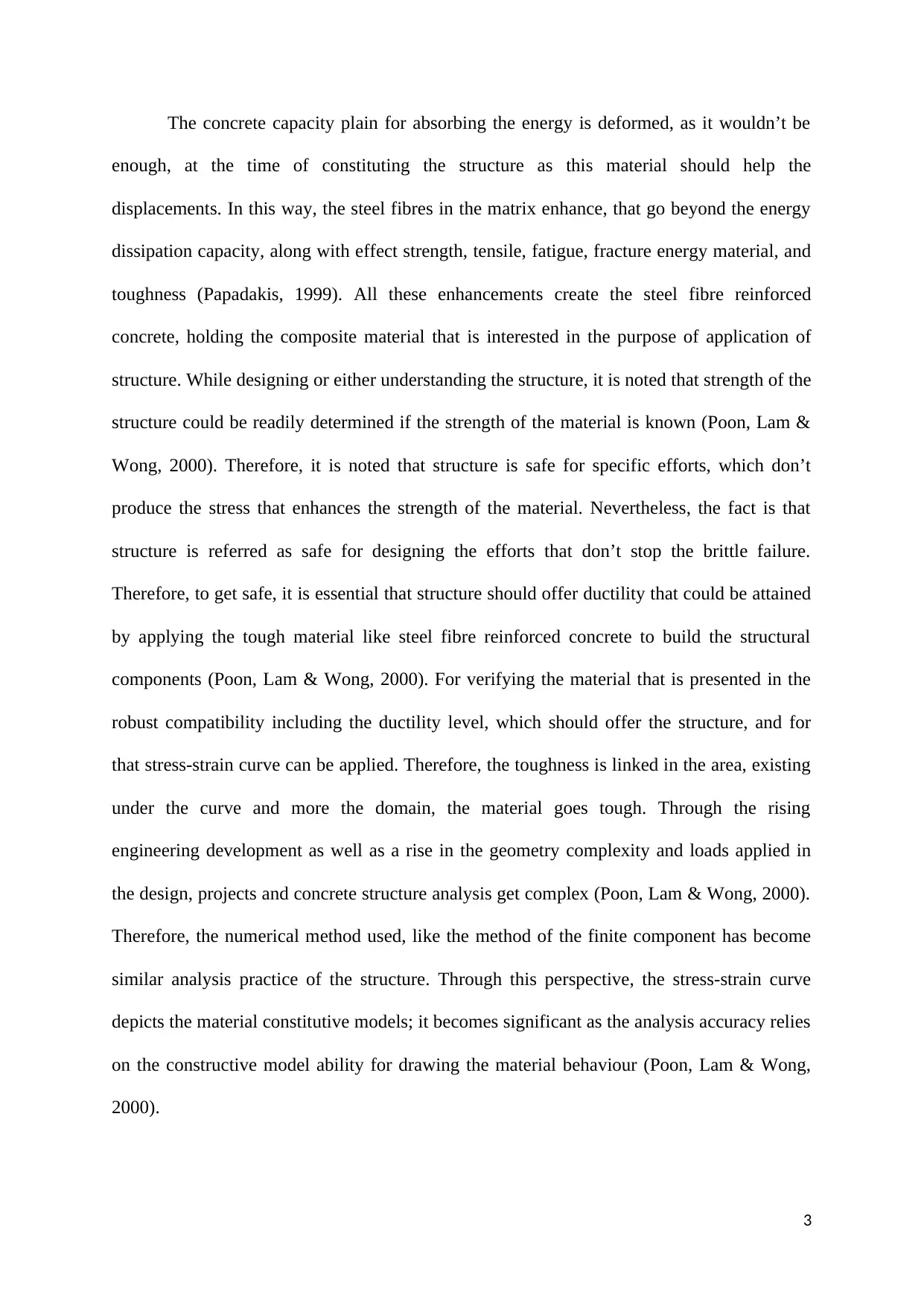
The concrete capacity plain for absorbing the energy is deformed, as it wouldn’t be
enough, at the time of constituting the structure as this material should help the
displacements. In this way, the steel fibres in the matrix enhance, that go beyond the energy
dissipation capacity, along with effect strength, tensile, fatigue, fracture energy material, and
toughness (Papadakis, 1999). All these enhancements create the steel fibre reinforced
concrete, holding the composite material that is interested in the purpose of application of
structure. While designing or either understanding the structure, it is noted that strength of the
structure could be readily determined if the strength of the material is known (Poon, Lam &
Wong, 2000). Therefore, it is noted that structure is safe for specific efforts, which don’t
produce the stress that enhances the strength of the material. Nevertheless, the fact is that
structure is referred as safe for designing the efforts that don’t stop the brittle failure.
Therefore, to get safe, it is essential that structure should offer ductility that could be attained
by applying the tough material like steel fibre reinforced concrete to build the structural
components (Poon, Lam & Wong, 2000). For verifying the material that is presented in the
robust compatibility including the ductility level, which should offer the structure, and for
that stress-strain curve can be applied. Therefore, the toughness is linked in the area, existing
under the curve and more the domain, the material goes tough. Through the rising
engineering development as well as a rise in the geometry complexity and loads applied in
the design, projects and concrete structure analysis get complex (Poon, Lam & Wong, 2000).
Therefore, the numerical method used, like the method of the finite component has become
similar analysis practice of the structure. Through this perspective, the stress-strain curve
depicts the material constitutive models; it becomes significant as the analysis accuracy relies
on the constructive model ability for drawing the material behaviour (Poon, Lam & Wong,
2000).
3
enough, at the time of constituting the structure as this material should help the
displacements. In this way, the steel fibres in the matrix enhance, that go beyond the energy
dissipation capacity, along with effect strength, tensile, fatigue, fracture energy material, and
toughness (Papadakis, 1999). All these enhancements create the steel fibre reinforced
concrete, holding the composite material that is interested in the purpose of application of
structure. While designing or either understanding the structure, it is noted that strength of the
structure could be readily determined if the strength of the material is known (Poon, Lam &
Wong, 2000). Therefore, it is noted that structure is safe for specific efforts, which don’t
produce the stress that enhances the strength of the material. Nevertheless, the fact is that
structure is referred as safe for designing the efforts that don’t stop the brittle failure.
Therefore, to get safe, it is essential that structure should offer ductility that could be attained
by applying the tough material like steel fibre reinforced concrete to build the structural
components (Poon, Lam & Wong, 2000). For verifying the material that is presented in the
robust compatibility including the ductility level, which should offer the structure, and for
that stress-strain curve can be applied. Therefore, the toughness is linked in the area, existing
under the curve and more the domain, the material goes tough. Through the rising
engineering development as well as a rise in the geometry complexity and loads applied in
the design, projects and concrete structure analysis get complex (Poon, Lam & Wong, 2000).
Therefore, the numerical method used, like the method of the finite component has become
similar analysis practice of the structure. Through this perspective, the stress-strain curve
depicts the material constitutive models; it becomes significant as the analysis accuracy relies
on the constructive model ability for drawing the material behaviour (Poon, Lam & Wong,
2000).
3
Paraphrase This Document
Need a fresh take? Get an instant paraphrase of this document with our AI Paraphraser
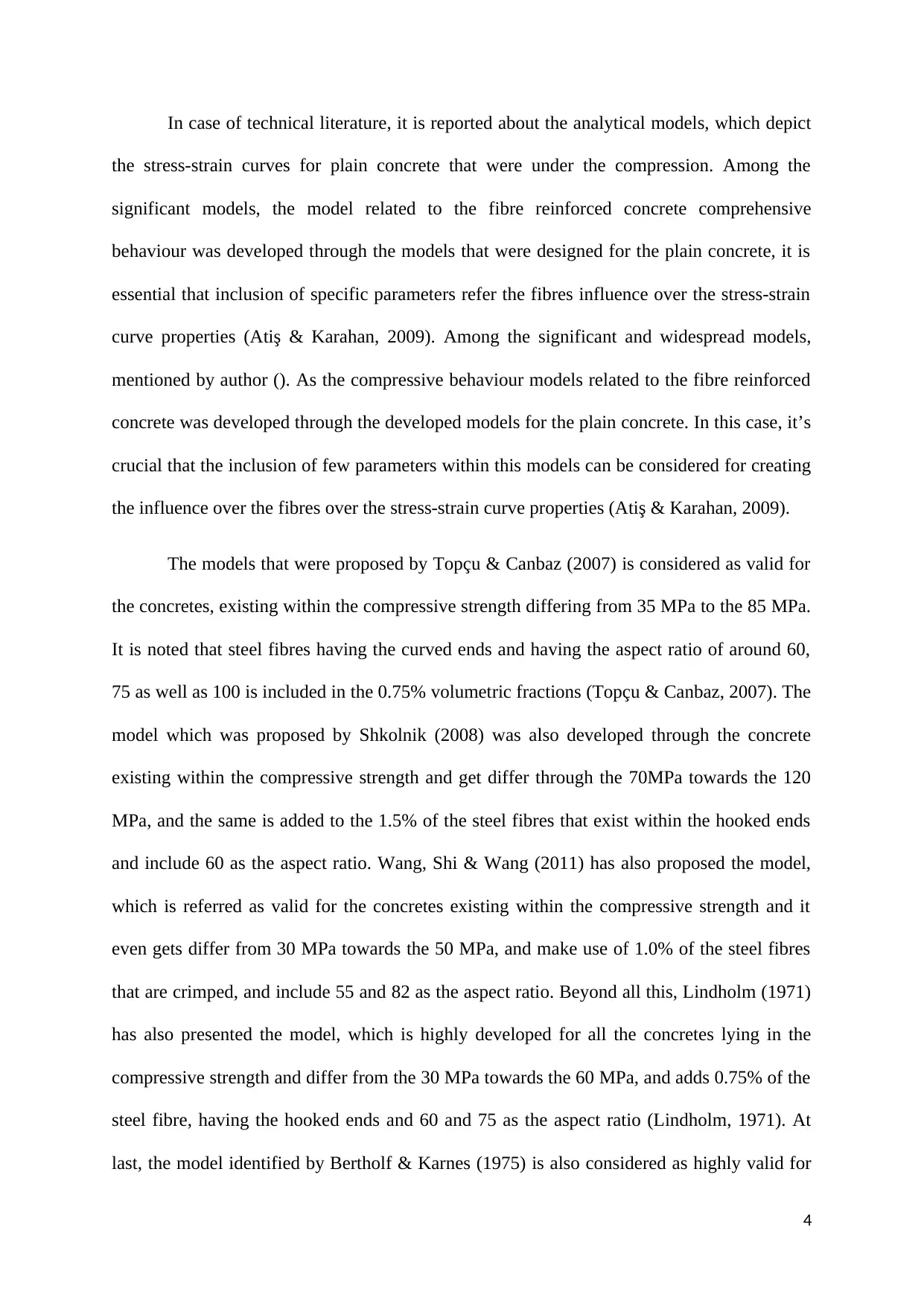
In case of technical literature, it is reported about the analytical models, which depict
the stress-strain curves for plain concrete that were under the compression. Among the
significant models, the model related to the fibre reinforced concrete comprehensive
behaviour was developed through the models that were designed for the plain concrete, it is
essential that inclusion of specific parameters refer the fibres influence over the stress-strain
curve properties (Atiş & Karahan, 2009). Among the significant and widespread models,
mentioned by author (). As the compressive behaviour models related to the fibre reinforced
concrete was developed through the developed models for the plain concrete. In this case, it’s
crucial that the inclusion of few parameters within this models can be considered for creating
the influence over the fibres over the stress-strain curve properties (Atiş & Karahan, 2009).
The models that were proposed by Topçu & Canbaz (2007) is considered as valid for
the concretes, existing within the compressive strength differing from 35 MPa to the 85 MPa.
It is noted that steel fibres having the curved ends and having the aspect ratio of around 60,
75 as well as 100 is included in the 0.75% volumetric fractions (Topçu & Canbaz, 2007). The
model which was proposed by Shkolnik (2008) was also developed through the concrete
existing within the compressive strength and get differ through the 70MPa towards the 120
MPa, and the same is added to the 1.5% of the steel fibres that exist within the hooked ends
and include 60 as the aspect ratio. Wang, Shi & Wang (2011) has also proposed the model,
which is referred as valid for the concretes existing within the compressive strength and it
even gets differ from 30 MPa towards the 50 MPa, and make use of 1.0% of the steel fibres
that are crimped, and include 55 and 82 as the aspect ratio. Beyond all this, Lindholm (1971)
has also presented the model, which is highly developed for all the concretes lying in the
compressive strength and differ from the 30 MPa towards the 60 MPa, and adds 0.75% of the
steel fibre, having the hooked ends and 60 and 75 as the aspect ratio (Lindholm, 1971). At
last, the model identified by Bertholf & Karnes (1975) is also considered as highly valid for
4
the stress-strain curves for plain concrete that were under the compression. Among the
significant models, the model related to the fibre reinforced concrete comprehensive
behaviour was developed through the models that were designed for the plain concrete, it is
essential that inclusion of specific parameters refer the fibres influence over the stress-strain
curve properties (Atiş & Karahan, 2009). Among the significant and widespread models,
mentioned by author (). As the compressive behaviour models related to the fibre reinforced
concrete was developed through the developed models for the plain concrete. In this case, it’s
crucial that the inclusion of few parameters within this models can be considered for creating
the influence over the fibres over the stress-strain curve properties (Atiş & Karahan, 2009).
The models that were proposed by Topçu & Canbaz (2007) is considered as valid for
the concretes, existing within the compressive strength differing from 35 MPa to the 85 MPa.
It is noted that steel fibres having the curved ends and having the aspect ratio of around 60,
75 as well as 100 is included in the 0.75% volumetric fractions (Topçu & Canbaz, 2007). The
model which was proposed by Shkolnik (2008) was also developed through the concrete
existing within the compressive strength and get differ through the 70MPa towards the 120
MPa, and the same is added to the 1.5% of the steel fibres that exist within the hooked ends
and include 60 as the aspect ratio. Wang, Shi & Wang (2011) has also proposed the model,
which is referred as valid for the concretes existing within the compressive strength and it
even gets differ from 30 MPa towards the 50 MPa, and make use of 1.0% of the steel fibres
that are crimped, and include 55 and 82 as the aspect ratio. Beyond all this, Lindholm (1971)
has also presented the model, which is highly developed for all the concretes lying in the
compressive strength and differ from the 30 MPa towards the 60 MPa, and adds 0.75% of the
steel fibre, having the hooked ends and 60 and 75 as the aspect ratio (Lindholm, 1971). At
last, the model identified by Bertholf & Karnes (1975) is also considered as highly valid for
4
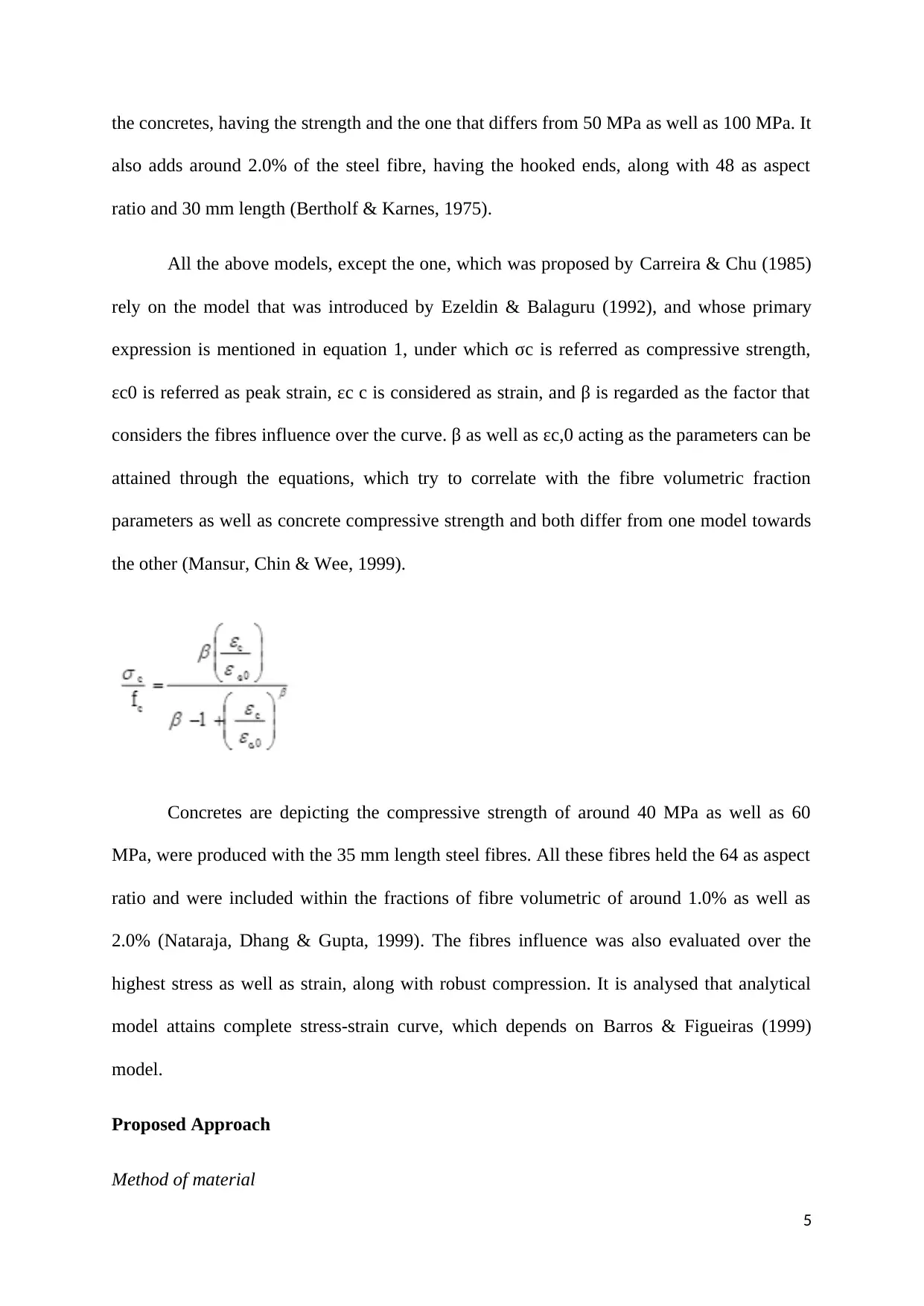
the concretes, having the strength and the one that differs from 50 MPa as well as 100 MPa. It
also adds around 2.0% of the steel fibre, having the hooked ends, along with 48 as aspect
ratio and 30 mm length (Bertholf & Karnes, 1975).
All the above models, except the one, which was proposed by Carreira & Chu (1985)
rely on the model that was introduced by Ezeldin & Balaguru (1992), and whose primary
expression is mentioned in equation 1, under which σc is referred as compressive strength,
εc0 is referred as peak strain, εc c is considered as strain, and β is regarded as the factor that
considers the fibres influence over the curve. β as well as εc,0 acting as the parameters can be
attained through the equations, which try to correlate with the fibre volumetric fraction
parameters as well as concrete compressive strength and both differ from one model towards
the other (Mansur, Chin & Wee, 1999).
Concretes are depicting the compressive strength of around 40 MPa as well as 60
MPa, were produced with the 35 mm length steel fibres. All these fibres held the 64 as aspect
ratio and were included within the fractions of fibre volumetric of around 1.0% as well as
2.0% (Nataraja, Dhang & Gupta, 1999). The fibres influence was also evaluated over the
highest stress as well as strain, along with robust compression. It is analysed that analytical
model attains complete stress-strain curve, which depends on Barros & Figueiras (1999)
model.
Proposed Approach
Method of material
5
also adds around 2.0% of the steel fibre, having the hooked ends, along with 48 as aspect
ratio and 30 mm length (Bertholf & Karnes, 1975).
All the above models, except the one, which was proposed by Carreira & Chu (1985)
rely on the model that was introduced by Ezeldin & Balaguru (1992), and whose primary
expression is mentioned in equation 1, under which σc is referred as compressive strength,
εc0 is referred as peak strain, εc c is considered as strain, and β is regarded as the factor that
considers the fibres influence over the curve. β as well as εc,0 acting as the parameters can be
attained through the equations, which try to correlate with the fibre volumetric fraction
parameters as well as concrete compressive strength and both differ from one model towards
the other (Mansur, Chin & Wee, 1999).
Concretes are depicting the compressive strength of around 40 MPa as well as 60
MPa, were produced with the 35 mm length steel fibres. All these fibres held the 64 as aspect
ratio and were included within the fractions of fibre volumetric of around 1.0% as well as
2.0% (Nataraja, Dhang & Gupta, 1999). The fibres influence was also evaluated over the
highest stress as well as strain, along with robust compression. It is analysed that analytical
model attains complete stress-strain curve, which depends on Barros & Figueiras (1999)
model.
Proposed Approach
Method of material
5
⊘ This is a preview!⊘
Do you want full access?
Subscribe today to unlock all pages.

Trusted by 1+ million students worldwide
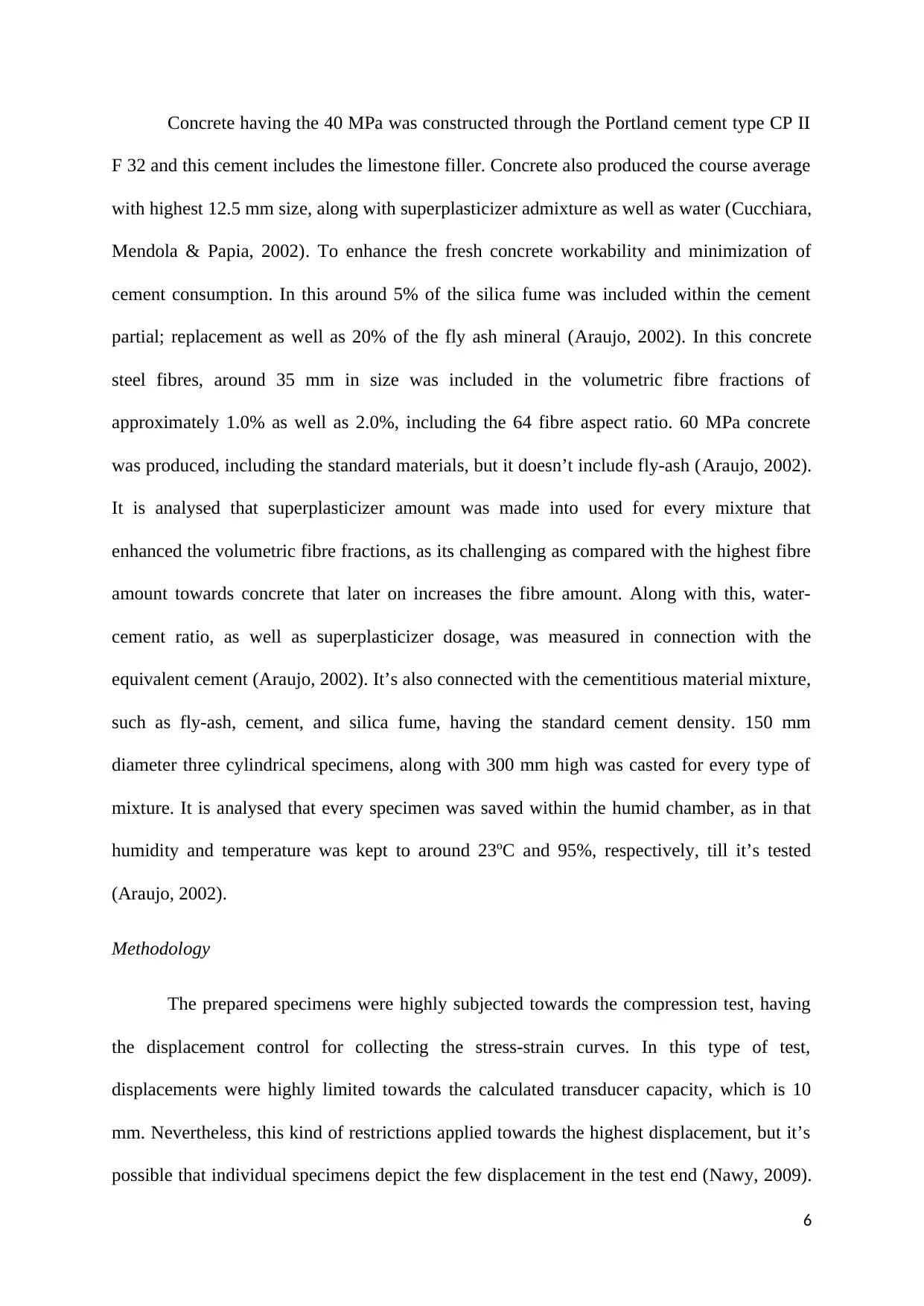
Concrete having the 40 MPa was constructed through the Portland cement type CP II
F 32 and this cement includes the limestone filler. Concrete also produced the course average
with highest 12.5 mm size, along with superplasticizer admixture as well as water (Cucchiara,
Mendola & Papia, 2002). To enhance the fresh concrete workability and minimization of
cement consumption. In this around 5% of the silica fume was included within the cement
partial; replacement as well as 20% of the fly ash mineral (Araujo, 2002). In this concrete
steel fibres, around 35 mm in size was included in the volumetric fibre fractions of
approximately 1.0% as well as 2.0%, including the 64 fibre aspect ratio. 60 MPa concrete
was produced, including the standard materials, but it doesn’t include fly-ash (Araujo, 2002).
It is analysed that superplasticizer amount was made into used for every mixture that
enhanced the volumetric fibre fractions, as its challenging as compared with the highest fibre
amount towards concrete that later on increases the fibre amount. Along with this, water-
cement ratio, as well as superplasticizer dosage, was measured in connection with the
equivalent cement (Araujo, 2002). It’s also connected with the cementitious material mixture,
such as fly-ash, cement, and silica fume, having the standard cement density. 150 mm
diameter three cylindrical specimens, along with 300 mm high was casted for every type of
mixture. It is analysed that every specimen was saved within the humid chamber, as in that
humidity and temperature was kept to around 23ºC and 95%, respectively, till it’s tested
(Araujo, 2002).
Methodology
The prepared specimens were highly subjected towards the compression test, having
the displacement control for collecting the stress-strain curves. In this type of test,
displacements were highly limited towards the calculated transducer capacity, which is 10
mm. Nevertheless, this kind of restrictions applied towards the highest displacement, but it’s
possible that individual specimens depict the few displacement in the test end (Nawy, 2009).
6
F 32 and this cement includes the limestone filler. Concrete also produced the course average
with highest 12.5 mm size, along with superplasticizer admixture as well as water (Cucchiara,
Mendola & Papia, 2002). To enhance the fresh concrete workability and minimization of
cement consumption. In this around 5% of the silica fume was included within the cement
partial; replacement as well as 20% of the fly ash mineral (Araujo, 2002). In this concrete
steel fibres, around 35 mm in size was included in the volumetric fibre fractions of
approximately 1.0% as well as 2.0%, including the 64 fibre aspect ratio. 60 MPa concrete
was produced, including the standard materials, but it doesn’t include fly-ash (Araujo, 2002).
It is analysed that superplasticizer amount was made into used for every mixture that
enhanced the volumetric fibre fractions, as its challenging as compared with the highest fibre
amount towards concrete that later on increases the fibre amount. Along with this, water-
cement ratio, as well as superplasticizer dosage, was measured in connection with the
equivalent cement (Araujo, 2002). It’s also connected with the cementitious material mixture,
such as fly-ash, cement, and silica fume, having the standard cement density. 150 mm
diameter three cylindrical specimens, along with 300 mm high was casted for every type of
mixture. It is analysed that every specimen was saved within the humid chamber, as in that
humidity and temperature was kept to around 23ºC and 95%, respectively, till it’s tested
(Araujo, 2002).
Methodology
The prepared specimens were highly subjected towards the compression test, having
the displacement control for collecting the stress-strain curves. In this type of test,
displacements were highly limited towards the calculated transducer capacity, which is 10
mm. Nevertheless, this kind of restrictions applied towards the highest displacement, but it’s
possible that individual specimens depict the few displacement in the test end (Nawy, 2009).
6
Paraphrase This Document
Need a fresh take? Get an instant paraphrase of this document with our AI Paraphraser
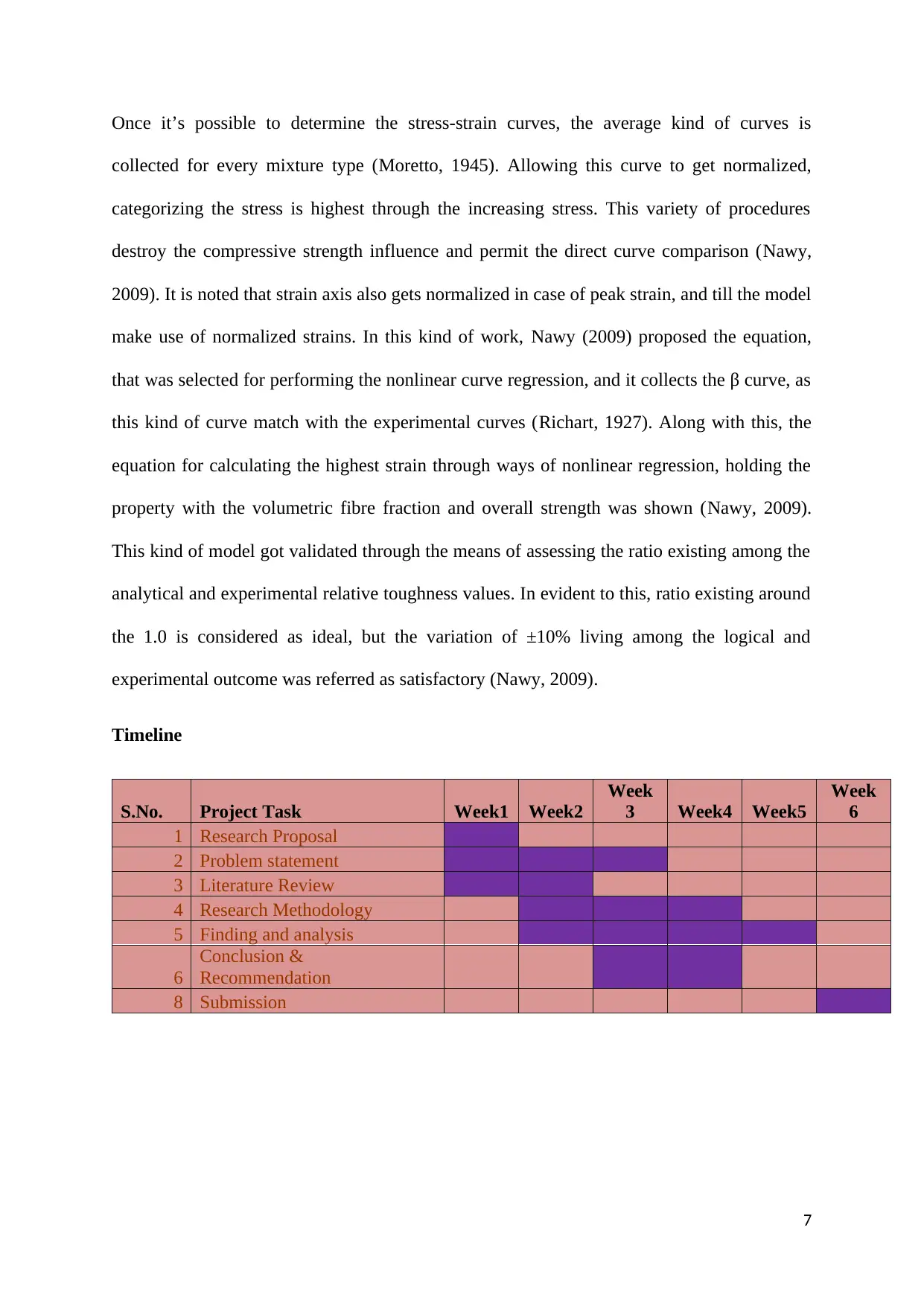
Once it’s possible to determine the stress-strain curves, the average kind of curves is
collected for every mixture type (Moretto, 1945). Allowing this curve to get normalized,
categorizing the stress is highest through the increasing stress. This variety of procedures
destroy the compressive strength influence and permit the direct curve comparison (Nawy,
2009). It is noted that strain axis also gets normalized in case of peak strain, and till the model
make use of normalized strains. In this kind of work, Nawy (2009) proposed the equation,
that was selected for performing the nonlinear curve regression, and it collects the β curve, as
this kind of curve match with the experimental curves (Richart, 1927). Along with this, the
equation for calculating the highest strain through ways of nonlinear regression, holding the
property with the volumetric fibre fraction and overall strength was shown (Nawy, 2009).
This kind of model got validated through the means of assessing the ratio existing among the
analytical and experimental relative toughness values. In evident to this, ratio existing around
the 1.0 is considered as ideal, but the variation of ±10% living among the logical and
experimental outcome was referred as satisfactory (Nawy, 2009).
Timeline
S.No. Project Task Week1 Week2
Week
3 Week4 Week5
Week
6
1 Research Proposal
2 Problem statement
3 Literature Review
4 Research Methodology
5 Finding and analysis
6
Conclusion &
Recommendation
8 Submission
7
collected for every mixture type (Moretto, 1945). Allowing this curve to get normalized,
categorizing the stress is highest through the increasing stress. This variety of procedures
destroy the compressive strength influence and permit the direct curve comparison (Nawy,
2009). It is noted that strain axis also gets normalized in case of peak strain, and till the model
make use of normalized strains. In this kind of work, Nawy (2009) proposed the equation,
that was selected for performing the nonlinear curve regression, and it collects the β curve, as
this kind of curve match with the experimental curves (Richart, 1927). Along with this, the
equation for calculating the highest strain through ways of nonlinear regression, holding the
property with the volumetric fibre fraction and overall strength was shown (Nawy, 2009).
This kind of model got validated through the means of assessing the ratio existing among the
analytical and experimental relative toughness values. In evident to this, ratio existing around
the 1.0 is considered as ideal, but the variation of ±10% living among the logical and
experimental outcome was referred as satisfactory (Nawy, 2009).
Timeline
S.No. Project Task Week1 Week2
Week
3 Week4 Week5
Week
6
1 Research Proposal
2 Problem statement
3 Literature Review
4 Research Methodology
5 Finding and analysis
6
Conclusion &
Recommendation
8 Submission
7
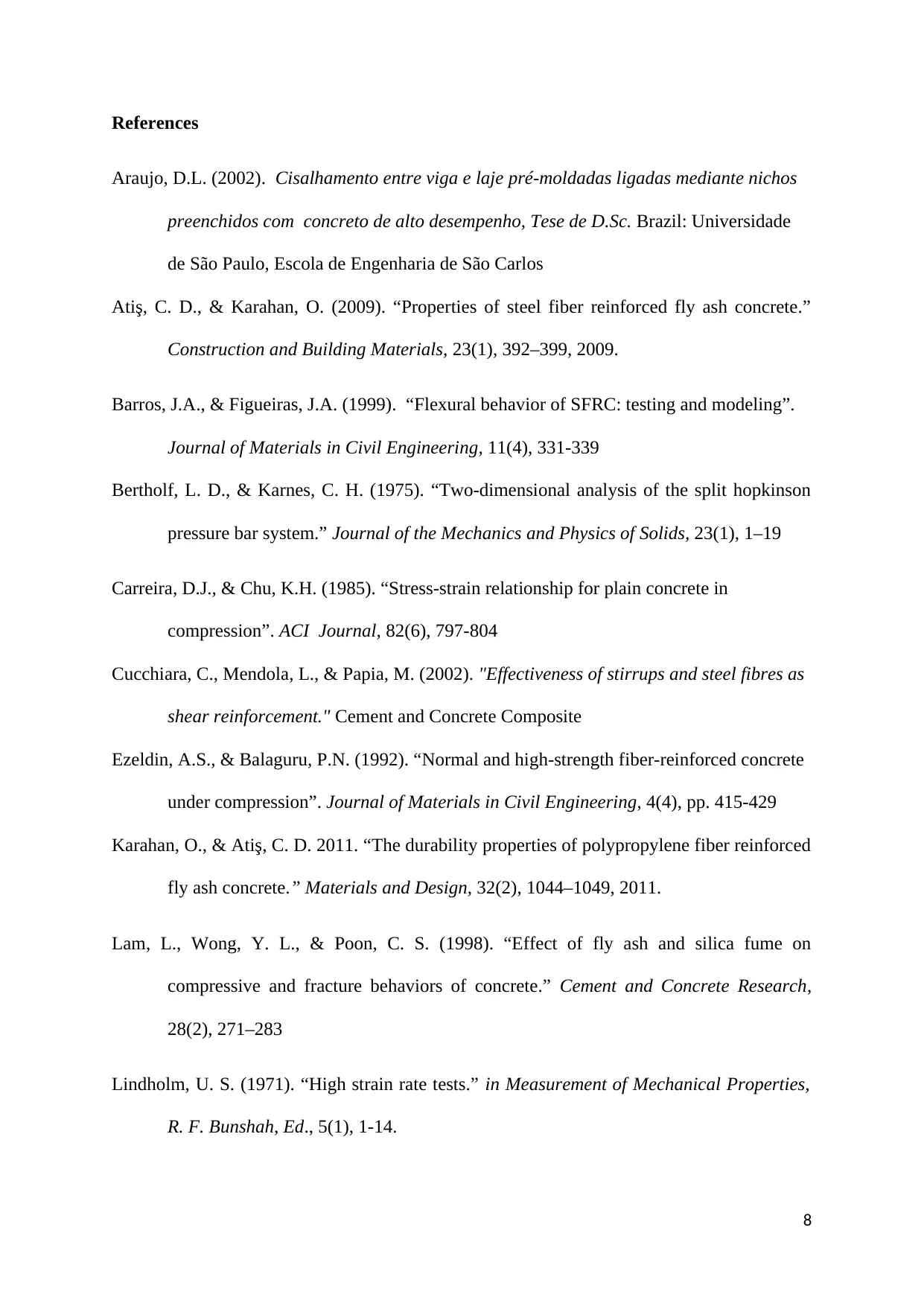
References
Araujo, D.L. (2002). Cisalhamento entre viga e laje pré-moldadas ligadas mediante nichos
preenchidos com concreto de alto desempenho, Tese de D.Sc. Brazil: Universidade
de São Paulo, Escola de Engenharia de São Carlos
Atiş, C. D., & Karahan, O. (2009). “Properties of steel fiber reinforced fly ash concrete.”
Construction and Building Materials, 23(1), 392–399, 2009.
Barros, J.A., & Figueiras, J.A. (1999). “Flexural behavior of SFRC: testing and modeling”.
Journal of Materials in Civil Engineering, 11(4), 331-339
Bertholf, L. D., & Karnes, C. H. (1975). “Two-dimensional analysis of the split hopkinson
pressure bar system.” Journal of the Mechanics and Physics of Solids, 23(1), 1–19
Carreira, D.J., & Chu, K.H. (1985). “Stress-strain relationship for plain concrete in
compression”. ACI Journal, 82(6), 797-804
Cucchiara, C., Mendola, L., & Papia, M. (2002). "Effectiveness of stirrups and steel fibres as
shear reinforcement." Cement and Concrete Composite
Ezeldin, A.S., & Balaguru, P.N. (1992). “Normal and high-strength fiber-reinforced concrete
under compression”. Journal of Materials in Civil Engineering, 4(4), pp. 415-429
Karahan, O., & Atiş, C. D. 2011. “The durability properties of polypropylene fiber reinforced
fly ash concrete.” Materials and Design, 32(2), 1044–1049, 2011.
Lam, L., Wong, Y. L., & Poon, C. S. (1998). “Effect of fly ash and silica fume on
compressive and fracture behaviors of concrete.” Cement and Concrete Research,
28(2), 271–283
Lindholm, U. S. (1971). “High strain rate tests.” in Measurement of Mechanical Properties,
R. F. Bunshah, Ed., 5(1), 1-14.
8
Araujo, D.L. (2002). Cisalhamento entre viga e laje pré-moldadas ligadas mediante nichos
preenchidos com concreto de alto desempenho, Tese de D.Sc. Brazil: Universidade
de São Paulo, Escola de Engenharia de São Carlos
Atiş, C. D., & Karahan, O. (2009). “Properties of steel fiber reinforced fly ash concrete.”
Construction and Building Materials, 23(1), 392–399, 2009.
Barros, J.A., & Figueiras, J.A. (1999). “Flexural behavior of SFRC: testing and modeling”.
Journal of Materials in Civil Engineering, 11(4), 331-339
Bertholf, L. D., & Karnes, C. H. (1975). “Two-dimensional analysis of the split hopkinson
pressure bar system.” Journal of the Mechanics and Physics of Solids, 23(1), 1–19
Carreira, D.J., & Chu, K.H. (1985). “Stress-strain relationship for plain concrete in
compression”. ACI Journal, 82(6), 797-804
Cucchiara, C., Mendola, L., & Papia, M. (2002). "Effectiveness of stirrups and steel fibres as
shear reinforcement." Cement and Concrete Composite
Ezeldin, A.S., & Balaguru, P.N. (1992). “Normal and high-strength fiber-reinforced concrete
under compression”. Journal of Materials in Civil Engineering, 4(4), pp. 415-429
Karahan, O., & Atiş, C. D. 2011. “The durability properties of polypropylene fiber reinforced
fly ash concrete.” Materials and Design, 32(2), 1044–1049, 2011.
Lam, L., Wong, Y. L., & Poon, C. S. (1998). “Effect of fly ash and silica fume on
compressive and fracture behaviors of concrete.” Cement and Concrete Research,
28(2), 271–283
Lindholm, U. S. (1971). “High strain rate tests.” in Measurement of Mechanical Properties,
R. F. Bunshah, Ed., 5(1), 1-14.
8
⊘ This is a preview!⊘
Do you want full access?
Subscribe today to unlock all pages.

Trusted by 1+ million students worldwide
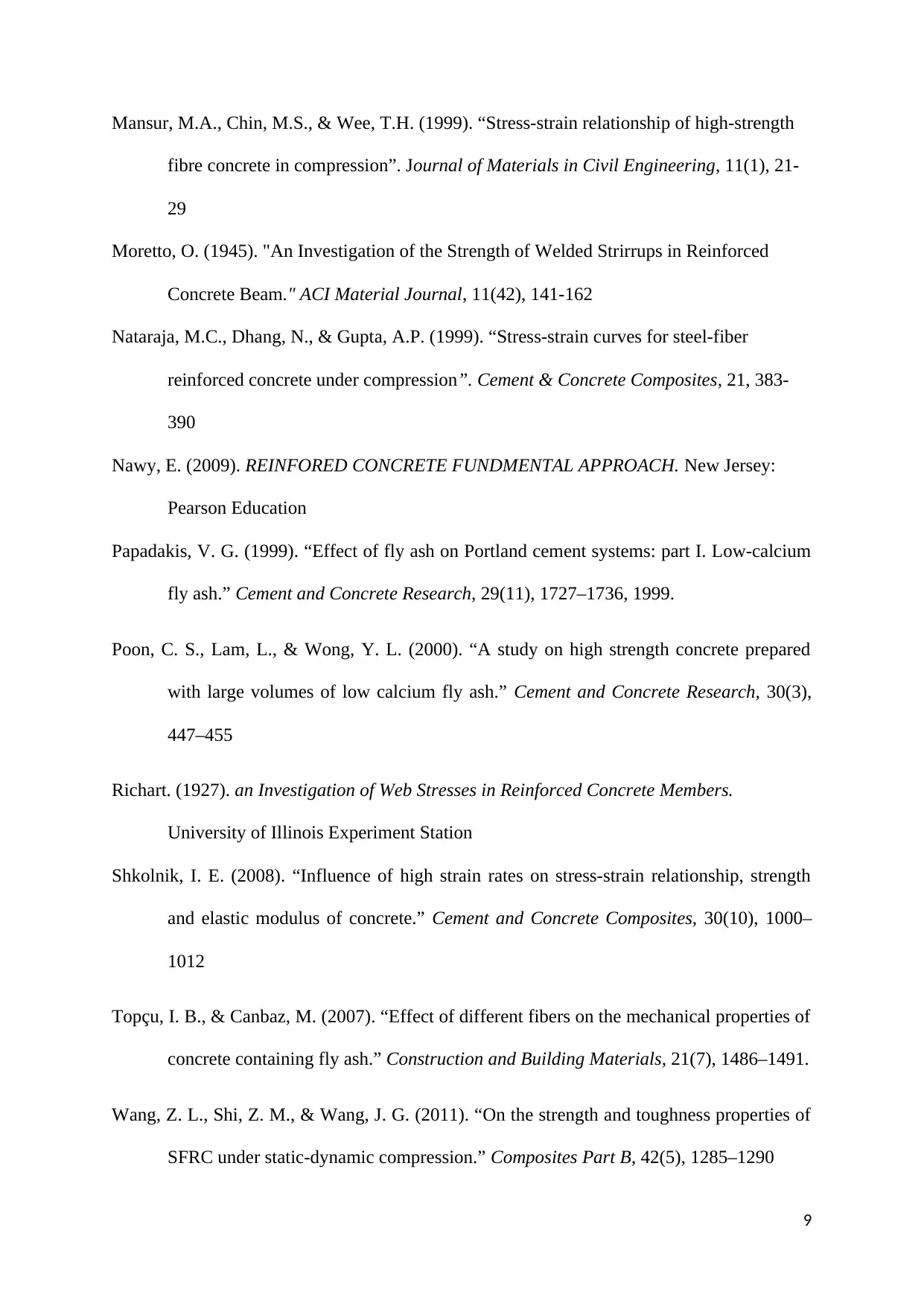
Mansur, M.A., Chin, M.S., & Wee, T.H. (1999). “Stress-strain relationship of high-strength
fibre concrete in compression”. Journal of Materials in Civil Engineering, 11(1), 21-
29
Moretto, O. (1945). "An Investigation of the Strength of Welded Strirrups in Reinforced
Concrete Beam." ACI Material Journal, 11(42), 141-162
Nataraja, M.C., Dhang, N., & Gupta, A.P. (1999). “Stress-strain curves for steel-fiber
reinforced concrete under compression”. Cement & Concrete Composites, 21, 383-
390
Nawy, E. (2009). REINFORED CONCRETE FUNDMENTAL APPROACH. New Jersey:
Pearson Education
Papadakis, V. G. (1999). “Effect of fly ash on Portland cement systems: part I. Low-calcium
fly ash.” Cement and Concrete Research, 29(11), 1727–1736, 1999.
Poon, C. S., Lam, L., & Wong, Y. L. (2000). “A study on high strength concrete prepared
with large volumes of low calcium fly ash.” Cement and Concrete Research, 30(3),
447–455
Richart. (1927). an Investigation of Web Stresses in Reinforced Concrete Members.
University of Illinois Experiment Station
Shkolnik, I. E. (2008). “Influence of high strain rates on stress-strain relationship, strength
and elastic modulus of concrete.” Cement and Concrete Composites, 30(10), 1000–
1012
Topçu, I. B., & Canbaz, M. (2007). “Effect of different fibers on the mechanical properties of
concrete containing fly ash.” Construction and Building Materials, 21(7), 1486–1491.
Wang, Z. L., Shi, Z. M., & Wang, J. G. (2011). “On the strength and toughness properties of
SFRC under static-dynamic compression.” Composites Part B, 42(5), 1285–1290
9
fibre concrete in compression”. Journal of Materials in Civil Engineering, 11(1), 21-
29
Moretto, O. (1945). "An Investigation of the Strength of Welded Strirrups in Reinforced
Concrete Beam." ACI Material Journal, 11(42), 141-162
Nataraja, M.C., Dhang, N., & Gupta, A.P. (1999). “Stress-strain curves for steel-fiber
reinforced concrete under compression”. Cement & Concrete Composites, 21, 383-
390
Nawy, E. (2009). REINFORED CONCRETE FUNDMENTAL APPROACH. New Jersey:
Pearson Education
Papadakis, V. G. (1999). “Effect of fly ash on Portland cement systems: part I. Low-calcium
fly ash.” Cement and Concrete Research, 29(11), 1727–1736, 1999.
Poon, C. S., Lam, L., & Wong, Y. L. (2000). “A study on high strength concrete prepared
with large volumes of low calcium fly ash.” Cement and Concrete Research, 30(3),
447–455
Richart. (1927). an Investigation of Web Stresses in Reinforced Concrete Members.
University of Illinois Experiment Station
Shkolnik, I. E. (2008). “Influence of high strain rates on stress-strain relationship, strength
and elastic modulus of concrete.” Cement and Concrete Composites, 30(10), 1000–
1012
Topçu, I. B., & Canbaz, M. (2007). “Effect of different fibers on the mechanical properties of
concrete containing fly ash.” Construction and Building Materials, 21(7), 1486–1491.
Wang, Z. L., Shi, Z. M., & Wang, J. G. (2011). “On the strength and toughness properties of
SFRC under static-dynamic compression.” Composites Part B, 42(5), 1285–1290
9
1 out of 10
Your All-in-One AI-Powered Toolkit for Academic Success.
+13062052269
info@desklib.com
Available 24*7 on WhatsApp / Email
![[object Object]](/_next/static/media/star-bottom.7253800d.svg)
Unlock your academic potential
Copyright © 2020–2025 A2Z Services. All Rights Reserved. Developed and managed by ZUCOL.
